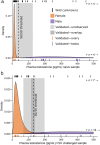Testosterone identifies hatchling sex for Mojave desert tortoises (Gopherus agassizii)
- PMID: 37684318
- PMCID: PMC10491821
- DOI: 10.1038/s41598-023-41677-2
Testosterone identifies hatchling sex for Mojave desert tortoises (Gopherus agassizii)
Abstract
The threatened Mojave desert tortoise (Gopherus agassizii) exhibits temperature-dependent sex determination, and individuals appear externally sexually monomorphic until sexual maturity. A non-surgical sex identification method that is suitable for a single in situ encounter with hatchlings is essential for minimizing handling of wild animals. We tested (1) whether plasma testosterone quantified by enzyme-linked immunosorbent assay differentiated males from females in 0-3 month old captive hatchlings, and (2) whether an injection of follicle-stimulating hormone (FSH) differentially elevates testosterone in male hatchlings to aid in identifying sex. We validated sex by ceolioscopic (laparoscopic) surgery. We then fit the testosterone concentrations to lognormal distributions and identified the concentration below which individuals are more likely female, and above which individuals are more likely male. Using a parametric bootstrapping procedure, we estimated a 0.01-0.04% misidentification rate for naïve testosterone samples, and a 1.26-1.39% misidentification rate for challenged (post-FSH injection) testosterone samples. Quantification of plasma testosterone concentration from small volume (0.1 mL) blood samples appears to be a viable, highly accurate method to identify sex of 0-3 month old hatchlings and could be a valuable tool for conservation measures and investigation of trends and variation in sex ratios for in situ wild nests.
© 2023. Springer Nature Limited.
Conflict of interest statement
The authors declare no competing interests.
Figures





References
-
- Rhodin AGJ, et al. Global conservation status of turtles and tortoises (Order Testudines) Chelonian Conserv. Biol. 2018;17:135–161.
-
- Bull JJ. Sex determination in reptiles. Q. Rev. Biol. 1980;55:3–21.
-
- Hulin V, Delmas V, Girondot M, Godfrey MH, Guillon J-M. Temperature-dependent sex determination and global change: Are some species at greater risk? Oecologia. 2009;160:493–506. - PubMed
-
- Jensen MP, et al. Environmental warming and feminization of one of the largest sea turtle populations in the world. Curr. Biol. 2018;28:154–159.e4. - PubMed
Publication types
MeSH terms
Substances
LinkOut - more resources
Full Text Sources

